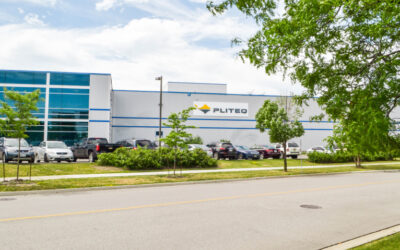It was 1893 in Chicago and the city was buzzing. The World’s Fair had brought massive numbers to the city to be part of this event on the cusp of a new century and take in the latest technology. But, as it got dark, a completely new experience for the rapt crowds was about to change the way of the whole world.
That was the moment at the World’s Fair when Westinghouse pulled a lever and switched on AC power, developed by famed inventor Nikola Tesla, to light the World Fair’s exhibits throughout the night. From that day on, people began to grasp the great potential in light to open up new ways of how we would work and live.
We’ve come a long way from that historic night, and although we may now not give light a second thought as we work away in our offices and homes, a lot of the work that we do really wouldn’t be possible without modern lighting. Lighting in workplaces is now fused into the entire ecosystem of the latest buildings.
The Internet of Things (IoT) has a lot to with this. It’s much more than lights turning on or off at a certain point of the day or night; now they adapt to situations and levels of activities. For instance, a company called Signify connects the IoT to LED lighting which results in an environment that offers not only more balanced lighting but also more efficient heating, while sensors collect data throughout the day and adjust lighting accordingly.
The software behind the lighting system allows users to take control of the lighting in small areas or throughout entire buildings or sites with a dashboard that indicates lighting levels and has the ability to manage them remotely.
This integration of light with technology is transformative. Before, lighting was just another function in a silo, like water and heat, but now we can bring all systems together to make for one efficient building.
And it’s not just about saving money on maintenance or power costs. It’s about communicating with occupants and gathering data. Knowing the flow of people and keeping the best lights on for people who are working late as well as making the most of the daylight that comes into the space.
Taking things a step further, Granby, a city in Quebec, is now working with a local energy company to change the city’s 5,794 lights to smart LEDs that will real-time remote management of all light fixtures to maximize efficiency and reduce maintenance costs. All just a little bit like that giant step forward in Chicago nearly 130 years ago.
“This lighting conversion will not only allow us to be more efficient and environmentally friendly but will also improve the safety of our citizens and our roads by increasing visibility,” Granby Mayor Julie Bourdon told Smart Cities World.
Smart lighting strives to optimize energy for the building and make things comfortable for its occupants. It’s also important to strike a balance between natural and artificial light. Living or working in a building without natural light deprives people of something that we all need.
The value of sunlight, especially for people who live in northern climes, hits home when those first bright, warm rays of light that come in the spring flood us with a sense of wellbeing.
Health sciences researchers from the Joanna Briggs Institute in Australia touch on the science of this: “As well as its necessity for Vitamin D synthesis, sunlight is the trigger for melatonin creation and the release which is vital to regulating circadian rhythms. Human beings have been designed to function optimally with light during the day and complete absence of light at night. People tend to feel better, more cheerful and energized in daylight.”
The presence or absence of natural daylight has a particular impact for people who live and work in buildings.
Architect Magazine notes the concept of daylighting in design principles: “Daylighting has been touted for its many aesthetic and health benefits by designers and researchers alike. Scientists at the Lighting Research Center (LRC) in Troy, New York, for example, have reported that daylit environments increase occupant productivity and comfort, and provide the mental and visual stimulation necessary to regulate human circadian rhythms.”
Building designers look at lighting that mimics the warmth and appeal of sunlight. There’s also the trend to incorporate more skylights, panoramic windows, and spacious communal rooms that help to bring the outdoors in—for many good reasons.
In fact, light has a surprisingly strong impact on employees in the workplace. The Harvard Business Review reported on a survey produced by Future Workplace, an HR advisory firm which polled 1,614 employees in North America about the impact of natural light and views of the outdoors in their workplace.
The survey found that these outdoor views are actually the number one factor of importance in the workplace environment. This outranks other bright and shiny perks like onsite childcare, cafeterias and fitness centers.
The inverse of all this is that 47 percent of employees claim they get tired or very tired from the absence of natural light.
As the benefits of natural light for employees take a front seat, more companies and architects are finding ways to re-imagine the workspace as a place that brings natural light into the lives of workers. Interestingly, they are even beginning to flaunt this as a recruiting tool.
An impressive example of this is The Spheres, Amazon headquarters in its hometown of Seattle. The Spheres is a workspace that is also a curated jungle with 2,000 plants. Amazon’s Spheres relies on the premise that natural light, plant life, and providing opportunities for healthy activities such as walking go a long way to reducing employee stress and improving job satisfaction.
As the name implies, The Spheres are three interconnected glass domes built on a vine-like metal framework. All of this creates an interior park that’s also a workspace for 800 people within a major corporation’s headquarters.
“We wanted a space for employees to collaborate and innovate,” says John Schoetter, Amazon Vice President for Global Real Estate and Facilities. “We asked ourselves: What’s missing from the modern office? We discovered that missing element was a link to nature.”
Light, both natural and artificial, is the driving force that makes The Spheres work. The domed structure itself allows for natural light throughout. And beyond the natural light, the artificial lighting is adjusted for both people and the plants that share the space.
These lights were developed for sports arenas and include the full spectrum of light. This is important because plants and people need different parts of the light spectrum for their health and function. The output of these lights was balanced to make them comfortable for both the employees and the plants that share the space.
There is an additional purpose for these lights—to focus inwards and draw people’s eyes to the warm, soothing green glow of the plants rather than the virtuosity of the architecture.
The Spheres are an oasis in a work environment. As Amazon claims: “The Spheres are a place where employees think and work differently, surrounded by nature and the wellness benefits it provides.”
While the plants are the focal point of The Spheres, this enviable workplace also shows us how much light matters in making a space work. The combination of smart lighting and well-planned natural lighting can make the workplace itself a more human, empathetic space and result in a creative and focused workforce.













